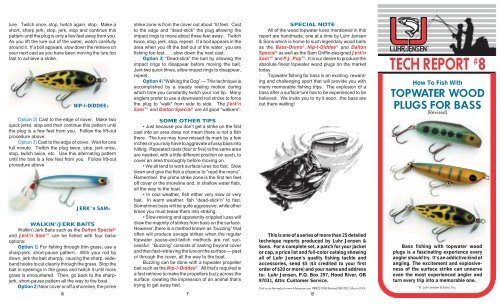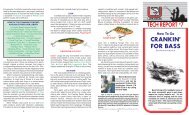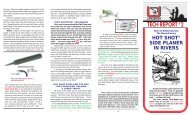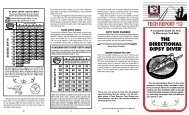#08 Topwater Plugs - Bayside Boat & Tackle
#08 Topwater Plugs - Bayside Boat & Tackle
#08 Topwater Plugs - Bayside Boat & Tackle
You also want an ePaper? Increase the reach of your titles
YUMPU automatically turns print PDFs into web optimized ePapers that Google loves.
lure. Twitch once, stop, twitch again, stop. Make a<br />
short, sharp jerk, stop, jerk, stop and continue this<br />
pattern until the plug is only a few feet away from you.<br />
As you lift the lure out of the water, watch carefully<br />
around it. If a boil appears, slow down the retrieve on<br />
your next cast as you have been moving the lure too<br />
fast to achieve a strike.<br />
NIP-I-DIDDEE®<br />
Option 2) Cast to the edge of cover. Make two<br />
quick jerks, stop and then continue this pattern until<br />
the plug is a few feet from you. Follow the lift-out<br />
procedure above.<br />
Option 3) Cast to the edge of cover. Wait for one<br />
full minute. Twitch the plug twice, stop, jerk once,<br />
stop, twitch twice, etc. Use this alternating pattern<br />
until the bait is a few feet from you. Follow lift-out<br />
procedure above<br />
JERK 'n SAM®<br />
WALKIN'/JERK BAITS<br />
Walkin’/Jerk Baits such as the Dalton Special ®<br />
and Jerk’n Sam can be fished with four basic<br />
options:<br />
Option 1) For fishing through thin grass, use a<br />
sharp-jerk, short-pause pattern. With your rod tip<br />
down, jerk the bait sharply, causing the sharp, widebend<br />
hooks to cut cleanly through the grass. Stop the<br />
bait in openings in the grass and twitch it until more<br />
grass is encountered. Then, go back to the sharpjerk,<br />
short-pause pattern all the way to the boat.<br />
Option 2) Near cover or off a shoreline, the prime<br />
strike zone is from the cover out about 10 feet. Cast<br />
to the edge and “dead-stick” the plug allowing the<br />
impact rings to move about three feet away. Twitch<br />
twice, stop, jerk, stop, repeat. If a boil appears in the<br />
area when you lift the bait out of the water, you are<br />
fishing too fast . . . slow down the next cast.<br />
Option 3) “Dead-stick” the bait by allowing the<br />
impact rings to disappear before moving the bait.<br />
Jerk two quick times, allow impact rings to disappear,<br />
repeat.<br />
Option 4) “Walking the Dog” — This technique is<br />
accomplished by a steady reeling motion during<br />
which time you constantly twitch your rod tip. Many<br />
anglers prefer to use a downward rod stroke to force<br />
the plug to “walk” from side to side. The Jerk’n<br />
Sam and Dalton Special ® are all good “walkers”.<br />
SOME OTHER TIPS<br />
• Just because you don’t get a strike on the first<br />
cast into an area does not mean there is not a fish<br />
there. The lure may have missed its mark by a few<br />
inches or you may have to aggravate a fussy bass into<br />
hitting. Repeated casts (four or five) to the same area<br />
are needed, with a little different position on each, to<br />
cover an area thoroughly before moving on.<br />
• We all tend to work surface lures too fast. Slow<br />
down and give the fish a chance to “read the menu”.<br />
Remember, the prime strike zone is the first ten feet<br />
off cover or the shoreline and, in shallow water flats,<br />
all the way to the boat.<br />
• In cool weather, fish either very slow or very<br />
fast. In warm weather, fish “dead-stick’n” to fast.<br />
Sometimes bass will be quite aggressive, while other<br />
times you must tease them into striking.<br />
• Slow-moving and apparently-crippled lures will<br />
draw the majority of strikes from bass on the surface.<br />
However, there is a method known as “buzzing” that<br />
often will produce savage strikes when the regular<br />
topwater pause-and-twitch methods are not successful.<br />
“Buzzing” consists of casting beyond cover<br />
and then fast-retrieving the lure on the surface — past<br />
or through the cover, all the way to the boat.<br />
Buzzing can be done with a topwater propeller<br />
bait such as the Nip-I-Diddee ® . All that’s required is<br />
a fast retrieve to make the propellers buzz across the<br />
surface, creating the impression of an animal that’s<br />
trying to get away fast.<br />
6 7<br />
SPECIAL NOTE<br />
All of the wood topwater lures mentioned in this<br />
report are handmade, one at a time by Luhr Jensen<br />
& Sons which is home to such legendary wood baits<br />
as the Bass-Oreno ® , Nip-I-Diddee ® and Dalton<br />
Special ® as well as the Sam Griffin-designed Jerk’n<br />
Sam and P.J. Pop. It is our desire to produce the<br />
absolute finest topwater wood plugs on the market<br />
today.<br />
<strong>Topwater</strong> fishing for bass is an exciting, rewarding<br />
and challenging sport that will provide you with<br />
many memorable fishing trips. The explosion of a<br />
bass after a surface lure has to be experienced to be<br />
believed. We invite you to try it soon...the bass are<br />
out there waiting!<br />
This is one of a series of more than 25 detailed<br />
technique reports produced by Luhr Jensen &<br />
Sons. For a complete set, a patch for your jacket<br />
or cap, a price list and full-color catalog showing<br />
all of Luhr Jensen's quality fishing tackle and<br />
accessories, send $5 ($3 credited to your first<br />
order of $20 or more) and your name and address<br />
to: Luhr Jensen, P.O. Box 297, Hood River, OR<br />
97031, Attn: Customer Service.<br />
Visit us on the web at www.luhrjensen.com #8822-008 Revised 060502 Litho in U.S.A.<br />
8<br />
TECH REPORT # 8<br />
How To Fish With<br />
TOPWATER WOOD<br />
PLUGS FOR BASS<br />
(Revised)<br />
Bass fishing with topwater wood<br />
plugs is a fascinating experience every<br />
angler should try. It's an addictive kind of<br />
angling. The excitement and explosiveness<br />
of the surface strike can unnerve<br />
even the most experienced angler and<br />
turn every trip into a memorable one.<br />
© Luhr Jensen & Sons, Inc.
Bass first become vulnerable to surface lures<br />
when the water warms up in the spring. These fish<br />
are a warm water species and are cold blooded, so<br />
their activity level rises proportional to water temperature<br />
increases. As water nears 60 degrees, bass,<br />
both largemouth and smallmouth, move into shallow<br />
bays and pockets looking for food and readying<br />
themselves for spawning. Once the water temperature<br />
has stabilized and spawning is finished, trips to<br />
these shallow areas will be limited to low light situations,<br />
such as early morning, late evening or on<br />
cloudy days.<br />
Although these time periods are considered<br />
"best", fish can be taken throughout the day on<br />
surface lures. Circumstances such as the amount of<br />
light, wind chop and cloud cover each play a part in<br />
terms of fish activity levels and feeding patterns, on<br />
any given day.<br />
Bass are especially susceptible to wood surface<br />
baits in the fall when they stay in warmer, shallower<br />
water for long periods of time. They seem to know<br />
that winter is on the way and increase their feeding<br />
activity as they sense the coming cold. This is when<br />
surface lures are at their best.<br />
DALTON SPECIAL®<br />
SNEAK ATTACKS<br />
Bass use cover to hide in so they can ambush<br />
their prey. Since they don’t normally chase anything<br />
very far, they rely on good ambush points to hide<br />
around (such as logs, brush piles or weedlines) so<br />
they can “sneak attack” baitfish and other meals.<br />
Since bass really are bottom dwellers, they consider<br />
deep water their “sanctuary”, so while they are in<br />
shallow areas looking for food much of the time, the<br />
one thing almost always nearby is an escape route to<br />
deep water.<br />
Accurate casting is essential if you wish to catch<br />
many bass. Mere inches can mean the difference<br />
between a fish and none. Casts should be made to<br />
openings in or near cover such as underneath or<br />
alongside a dock, inches away from a stickup, between<br />
lily pads, over submerged objects which lie just<br />
under the surface, etc.<br />
Bass feed on large organisms such as crayfish,<br />
minnows, salamanders or frogs. Any small animal or<br />
bug that lands near a bass in ambush is a likely meal<br />
and this is what makes surface lures so deadly . . .<br />
they imitate these easy meals.<br />
Bass are savage and aggressive eaters and,<br />
whether it’s a plug fished just under the surface or on<br />
top, you’ll have no doubt about the strike.<br />
COLORS/SIZES<br />
Bass do react differently to different surface lure<br />
types and finishes, but once you have found the right<br />
lure, color and action, they won't hesitate to react<br />
immediately. Bass normally only see the silhouette of<br />
the plug on dark or cloudy days. This is when dark<br />
baits work best, while chrome or light shades work<br />
best during bright light conditions.<br />
On calm days, smaller plugs with less noisemaking<br />
capabilities work better, while you need a real<br />
noisy plug to create disturbance on windy days.<br />
In clear water, color is more important because<br />
the fish strike by sight. In murky water, bass usually<br />
will react to vibrations, so noisier plugs work better.<br />
WATCH THE WAKE<br />
A topwater plug placed within immediate striking<br />
range of an aggressive bass will result in the kind of<br />
explosion that will shatter the calm of the water’s<br />
surface and most likely your nerves!<br />
Sometimes a bass from a long ways off, will take<br />
off submarining just under the surface toward the bait,<br />
and many times you will see the wake coming. If you<br />
can keep the plug working without panicking, you are<br />
in for some unbelievable strikes!<br />
At this time it is important to mention that you<br />
NEVER want to “set the hook” when a fish busts your<br />
surface plug. If you’ve already experienced this,<br />
you’ve probably found your hook-up-to-strike ratio<br />
very low. Wait until you FEEL the weight of the fish on<br />
your rod before you set. If you don’t wait for that<br />
“weight”, more than likely you’re the one going to get<br />
hooked.<br />
Sometimes bass blast a bait, only to hit it with<br />
their tail to kill it and then pounce on it again to eat it.<br />
The angler with the nerve to keep that bait in the area<br />
and not set the hook until the bass can be felt will be<br />
rewarded.<br />
TACKLE TIPS<br />
<strong>Tackle</strong> for topwater plug fishing will differ with<br />
individual anglers, but general guidelines are to choose<br />
a rod with a fast taper action from a light, sensitive tip<br />
to a solid butt section. The light tip is necessary to<br />
impart the best action to the plug and a solid butt is<br />
needed to help pull bass away from the cover they<br />
almost certainly will head for once hooked. Line<br />
should test from 10 to 17 pounds and should be of thin<br />
diameter, be abrasion resistant and have high knot<br />
strength. Trilene XT ® is such a line.<br />
Sharp hooks are critical in all fishing situations.<br />
Hooks on plugs must be super sharp to ensure their<br />
effectiveness. Small files have proved to be the<br />
absolute best sharpening tools for fish hooks and the<br />
Sharp Hook File produces needle-sharp points in<br />
seconds. Place the file parallel to the hook point and,<br />
with gentle one-way strokes, remove a small amount<br />
of metal from at least two sides of the point, resulting<br />
in both a needle-sharp point and knife-like cutting<br />
edge.<br />
<strong>Topwater</strong> wood lures can be divided into several<br />
categories including surface chuggers/darters, poppers,<br />
jerk baits/walkin’ baits and propeller baits. Here<br />
are some proven techniques for fishing each type:<br />
SURFACE CHUGGERS/DARTERS<br />
Two basic options for fishing wood surface chuggers/darters<br />
such as the Bass-Oreno ® which darts<br />
underwater when twitched and then floats back to the<br />
top are:<br />
BASS-ORENO®<br />
Option 1) For fishing near deep dropoffs and<br />
points, the Bass-Oreno ® can be used either as a<br />
darter or subsurface wobbling bait. A unique feature<br />
of this lure is its ability, after being twitched under the<br />
surface, to pop back to almost its original starting<br />
position. To fish as a darter, use a sharp jerk which<br />
causes the bait to splash and pop water on the<br />
surface before darting under. Then pause, allowing<br />
the bait to resurface. Jerk again, pause and repeat.<br />
A Bass-Oreno ® can be used at any point during<br />
this pattern as a subsurface, side-to-side wobbling<br />
bait simply by using a steady retrieve. Many anglers<br />
prefer to fish the plug with the sharp jerk-pause<br />
pattern for several feet, switch to a straight subsurface<br />
retrieve for the next several feet and then allow<br />
the bait to resurface and start the process over again.<br />
Option 2) Use a twitch-and-pause pattern when<br />
fishing shorelines or water adjacent to cover. Work it<br />
all the way to the boat, keeping your eyes open for a<br />
boil adjacent to the boat. If one is observed, lengthen<br />
the pause time between twitches on the next cast.<br />
P.J. POP<br />
Prop Baits<br />
There are three basic options available for fishing<br />
propeller baits such as the Nip-I-Diddee ® .<br />
Option 1) Cast to the edge of cover and let the<br />
impact rings move about three feet away from the<br />
2 3 4 5







